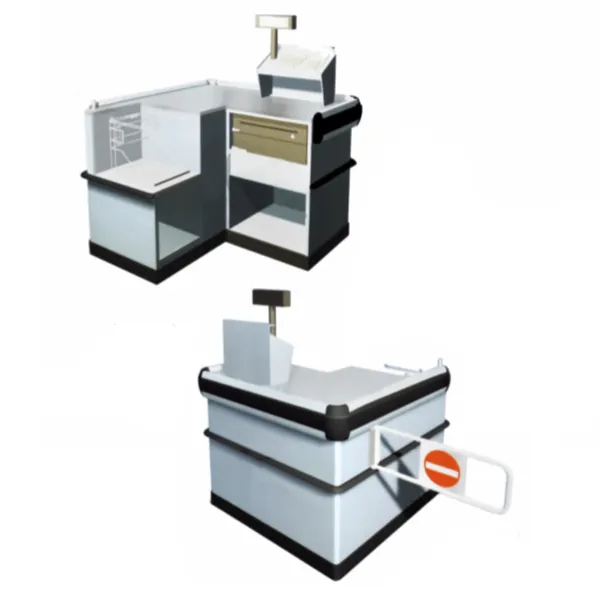Optimizing Layouts for Checkout Counter Design Efficiency
The design and layout of checkout counters are crucial in retail environments. This article explores strategic approaches to improve checkout efficiency and enhance customer satisfaction.
Space Planning for Smooth Customer Flow
Good layout design makes all the difference when it comes to smooth transactions and happy customers. Research shows stores with smart spatial arrangements cut down wait times around 30% for shoppers, which explains why retailers spend so much time on checkout area planning. Wide walking paths between registers and counters positioned where they make sense help avoid those frustrating traffic jams at busy hours. When people can actually get through without bumping into each other, everyone leaves satisfied. Another thing worth noting is how important sight lines are for staff working behind the counter. Clear visibility helps workers spot problems faster while making customers feel safer knowing someone can see what's happening. A good layout isn't just about looks it creates practical advantages too, from preventing theft to keeping operations running smoothly during rush periods.
Strategic Placement of Payment Terminals
Putting payment terminals at a comfortable height where people can easily reach them follows basic ergonomic rules and cuts down on physical strain for everyone involved, from cashiers to shoppers. When stores place these machines in smart spots, it really helps keep transactions flowing smoothly without those annoying long waits. Many retailers set up specific areas for payments right next to checkout counters, which speeds things up considerably during busy periods. Some businesses even look at sales data to figure out when crowds tend to form most often, then move terminals around as needed throughout the day. The result? A store layout that actually works better for customers, making their final moments in the shop less stressful and more satisfying overall.
Ergonomic Principles in Checkout Counter Design
Counter heights that can be adjusted are really important for serving both customers and staff who come in all shapes and sizes. When counters are set at the right height for different people, it makes things more inclusive and actually speeds up service because folks don't have to strain or reach awkwardly. Studies on ergonomics back this up too, finding that these kinds of adjustments cut down on workplace injuries and help tired employees feel better after their shifts, maybe around 20% improvement according to some reports. Beyond just making work easier, adjustable counters help businesses stay within ADA guidelines while building a positive image as places that care about accessibility for everyone who walks through the door.
Material Choices for Comfort and Durability
The materials selected really matter when it comes to both comfort and how long checkout counters will last. Solid wood options or those composite materials that have been strengthened tend to work best because they don't wear out so quickly. This means fewer replacements down the road which saves money for businesses over time. Cashiers also appreciate counters with softer surfaces since their hands don't get as tired during long shifts. Many people who know this industry well point out that surfaces which wipe clean easily make a big difference too. Keeping things sanitary helps stop germs from spreading around, something that became super important after all the pandemic stuff happened. Health concerns just won't go away anytime soon, so good cleaning properties remain a must have feature.
Technology Integration in Modern Checkout Counters
Adding contactless payments and digital screens at checkout counters really cuts down on wait times and makes shoppers happier overall. With so many people still worried about germs after all this pandemic stuff, stores that go touch-free are doing customers a real favor by keeping hands off everything. The digital side of things also helps run loyalty programs smoother, something that keeps folks coming back again and again. Some research from last year showed how big this trend has gotten too - around seven out of ten shoppers now want to tap their cards instead of handing them over. Retailers who don't get on board with these changes risk falling behind competitors who already see contactless tech as essential rather than optional.
AI-Driven Queue Management Tools
Adding AI powered queue management at checkout counters makes a big difference for customer service since these systems predict wait times and help managers allocate staff better. The smart tech looks at how customers move through stores and adjusts service speed on the fly, which matters most during busy periods when stores report around 15% improvement in handling rush hour crowds. According to recent studies, companies that install these kinds of smart checkout systems tend to get much higher ratings from shoppers about their overall experience. Retailers who implement AI queue solutions find that shoppers stay happier throughout their visit because there's less frustration waiting in line, something that definitely impacts repeat business.
Sustainable Materials for Eco-Friendly Checkout Design
Using recycled materials for checkout counters represents a move toward greener operations that fits well with today's business priorities. Stores are finding ways to cut down on waste while meeting customer expectations for greener shopping experiences. Switching to LED lighting makes sense too since these lights eat up far less electricity than traditional bulbs. Some businesses report cutting their lighting bills by around three quarters after making the switch, which adds up over time. Studies show companies that go green tend to build stronger connections with shoppers who care about the environment. These customers often become repeat buyers and spread the word about brands they feel good about supporting.
Modular Designs for Long-Term Adaptability
Modular checkout counter designs offer real flexibility that helps stores keep up with changing shopping habits and business requirements. Companies that go for flexible setups save money in the long run since they don't have to throw out old counters when things change. Take retail stores for instance many just rearrange existing modules instead of spending thousands on brand new equipment. Research shows workplaces that can adapt tend to draw better staff and actually keep employees longer too. The ability to modify spaces makes all the difference in creating work areas that work well today while still being ready for whatever comes next in operations.

Security Features in Checkout Counter Design
When designing checkout counters, security should definitely come first if stores want to cut down on theft problems and related losses. Putting in good quality anti-theft equipment really makes a difference according to some research showing shrinkage drops by around 25 percent in many cases. Stores can do this by placing locks and other tamper resistant parts where they actually matter most, especially around money handling zones. Retail consultants often point out that making sure staff have clear sight lines across the checkout area helps prevent would be thieves from getting away with anything. These kinds of security upgrades protect company assets for sure, but they also make shoppers feel safer when paying for their purchases. And let's face it, happy customers who don't worry about walking past suspicious characters tend to spend more money overall.
Surveillance Integration and Tamper-Proof Surfaces
Putting surveillance systems into checkout counters makes sense for store security. The cameras let staff watch what's happening right then, which tends to keep shoplifters away most of the time. Stores also benefit from using surfaces that don't get damaged easily. These materials last longer and still look good after years of use. According to research published by loss prevention experts, stores that invest in better counter designs see around 40% less inventory disappearing each month. Retailers who mix different security features together usually find their stores safer overall. Many big chain managers report fewer incidents when they combine camera coverage with durable materials at checkout areas.
Future-Proofing Checkout Counter Design
When checkout counters come equipped with tech mounting systems that allow upgrades, they tend to last longer and stay relevant even as tech changes over time. Stores need to keep pace with these changes if they want to remain competitive in today's fast moving retail world. Modular tech setups let businesses make gradual improvements to their checkout areas without breaking the bank on complete overhauls all at once. Market research shows retailers who keep their tech current generally perform better both competitively and operationally. Take for instance when stores install newer point of sale systems or add contactless payment methods - customers notice the difference, transactions go smoother, and everyone ends up happier with the whole shopping process.
Adaptive Layouts for Emerging Retail Trends
Retailers who build checkout areas with flexible designs find themselves better positioned in today's ever-changing marketplace where consumer habits shift almost overnight. When counters can be rearranged or modified easily, stores gain an edge when responding to what shoppers want right now, which often translates into better bottom lines too. Some retailers report seeing their sales jump around 15% after making these kinds of adjustments. The ability to tweak layouts on short notice means companies don't have to spend thousands on complete overhauls just because shopping patterns changed again. Industry insiders point out that maintaining this kind of design flexibility isn't just good practice but practically necessary given how fast retail trends develop nowadays. Stores that move faster than competitors with fresh ideas and promotions tend to attract more foot traffic and keep customers coming back week after week.
FAQ
Why is strategic placement of payment terminals important?
Strategic placement of payment terminals is crucial as it enhances accessibility and reduces physical strain, facilitating faster transactions and improving customer satisfaction.
How do ergonomic principles benefit checkout counter design?
Ergonomic principles in checkout counter design reduce workplace injuries and fatigue, ensure ADA compliance, and enhance overall efficiency and inclusivity.
What role does AI play in managing checkout queues?
AI-driven queue management tools improve customer service by predicting wait times, optimizing staff allocation, and enhancing efficiency during peak hours.
How do sustainable materials benefit checkout counter design?
Sustainable materials minimize environmental impact, reduce costs, and enhance brand image by attracting eco-conscious consumers, boosting loyalty and engagement.
What security features should be integrated into checkout counter design?
Security features such as anti-theft hardware and surveillance systems should be integrated to reduce shrinkage, protect assets, and enhance customer satisfaction.
Table of Contents
- Optimizing Layouts for Checkout Counter Design Efficiency
- Space Planning for Smooth Customer Flow
- Strategic Placement of Payment Terminals
- Technology Integration in Modern Checkout Counters
- Sustainable Materials for Eco-Friendly Checkout Design
- Security Features in Checkout Counter Design
- Future-Proofing Checkout Counter Design
-
FAQ
- Why is strategic placement of payment terminals important?
- How do ergonomic principles benefit checkout counter design?
- What role does AI play in managing checkout queues?
- How do sustainable materials benefit checkout counter design?
- What security features should be integrated into checkout counter design?

